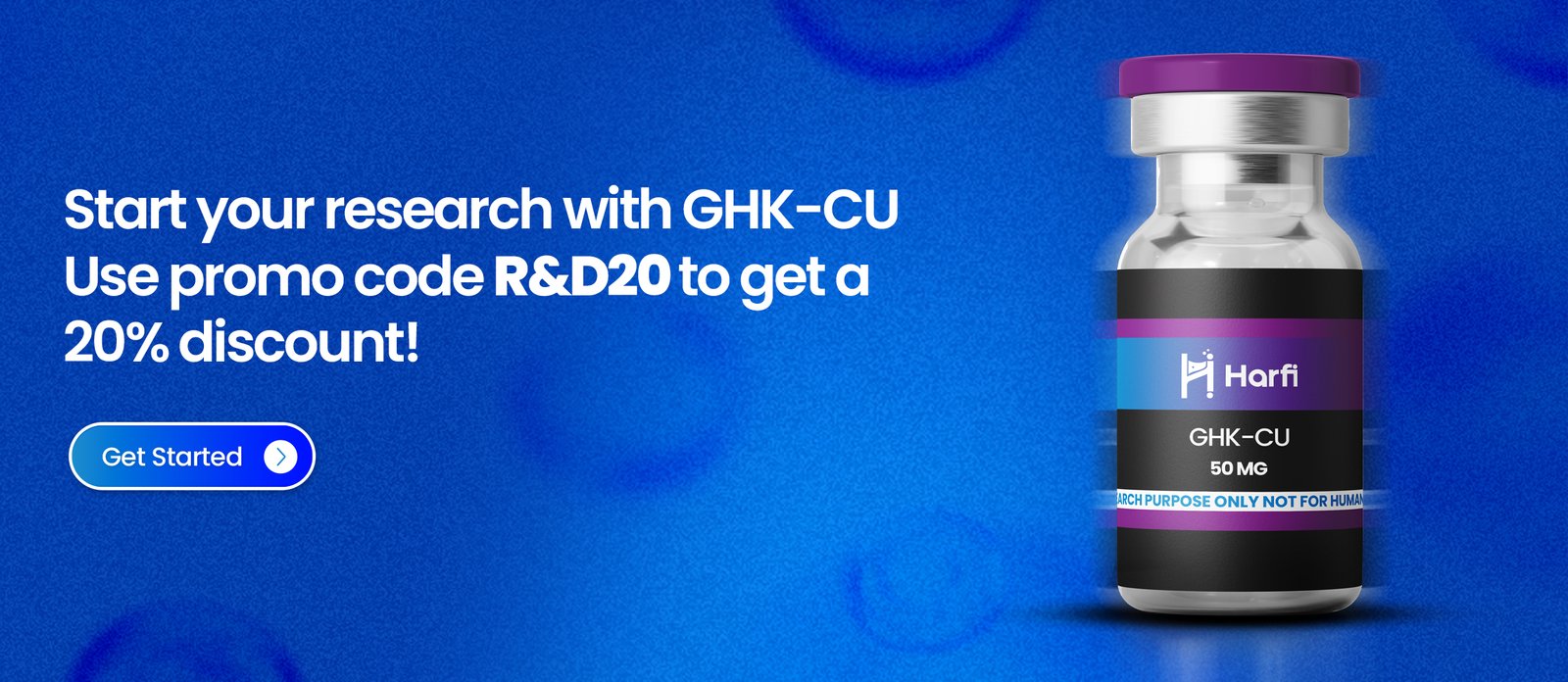GHK-Cu (Copper Peptide)
GHK-Cu (Copper Peptide) is a naturally occurring peptide found in human blood plasma, urine, and saliva. Animal studies suggest that GHK-Cu supports wound healing, enhances immune function, and improves skin health by stimulating collagen production, activating fibroblasts, and promoting blood vessel growth. Research also indicates that it serves as a feedback signal following tissue injury. Additionally, GHK-Cu acts as a powerful antioxidant by suppressing free-radical damage.
Product Usage
This product is intended for research purposes only. It is strictly designated for in vitro testing and laboratory experimentation. All information provided on this website is for educational purposes only. Any introduction into humans or animals is strictly prohibited by law. Only licensed, qualified professionals should handle this product. It is not a drug, food, or cosmetic and must not be misbranded, misused, or mislabeled as such.
What is GHK-Cu?
GHK-Cu is a naturally occurring peptide initially discovered in human blood plasma and later identified in urine and saliva. Research has shown that this short peptide offers significant benefits for wound healing and immune function. It possesses anti-aging properties, helps suppress free-radical damage, boosts protein synthesis, combats bacteria, and supports skin health by enhancing skin fibroblast activity.
Structure
Sequence: Gly-His-Lys.Cu.xHAc
Molecular Formula: C14H23CuN6O4
Molecular Weigh:340.384 g/mol
PubChem CID: 73587
CAS Number: 89030-95-5

Research on GHK-Cu
GHK-Cu, a naturally occurring component of human blood, plays a vital role in skin regeneration. Studies on skin cultures indicate that GHK stimulates both the production and breakdown of essential skin components, including collagen, glycosaminoglycans, proteoglycans, and chondroitin sulfate. This effect is partly due to its ability to attract and regulate fibroblasts, immune cells, and endothelial cells at injury sites.
Commonly used in skincare and cosmetic products, GHK-Cu enhances skin elasticity, firms and tightens the skin, and helps reduce sun damage, hyperpigmentation, fine lines, and wrinkles. Additionally, it aids in scar reduction, prevents hypertrophic healing, smooths rough skin, and rejuvenates aging skin. These benefits are partly linked to its influence on transforming growth factor-β and gene transcription.
GHK-Cu and Wound Healing
Research in mice has shown that GHK-Cu can accelerate wound healing by up to 33% following burns. This improvement is due not only to its ability to recruit immune cells and fibroblasts but also to its role in promoting blood vessel growth—an essential factor in burn wound care, where tissue damage often restricts circulation.
GHK-Cu’s Antimicrobial Properties
Infections from bacteria and fungi can significantly delay the wound healing process, particularly in burn victims and individuals with compromised immune systems, such as those with diabetes or HIV. When combined with specific fatty acids, GHK-Cu forms a powerful antimicrobial compound effective against various pathogens that hinder healing.
Studies in diabetic patients have shown that adding GHK-Cu to standard wound care leads to a 40% increase in wound closure rates and a 27% reduction in infections compared to conventional treatments. Similar benefits have been observed in patients with ischemic open wounds, highlighting GHK-Cu’s potential in advanced wound management.
GHK-Cu’s Impact on Cognition and Nervous System Function
The exact mechanisms behind neuron degeneration in conditions like Alzheimer’s remain unclear, making treatment development challenging. However, research suggests that GHK-Cu may help counter age-related declines in neuron function, a key factor in neurodegenerative diseases. Studies indicate that GHK-Cu supports angiogenesis in the nervous system, promotes nerve growth, and reduces central nervous system inflammation. Additionally, evidence suggests it can reset abnormal gene expression, potentially restoring proper function in impaired systems.
GHK-Cu is naturally present in significant concentrations in the brain, but its levels decline with age. Scientists hypothesize that this reduction may contribute to increased vulnerability of nervous system tissues to gene dysregulation and other damaging factors, potentially playing a role in neurodegeneration beyond disease onset.
Rodent studies suggest that GHK-Cu may protect brain tissue by inhibiting apoptosis, possibly by modulating the miR-339-59/VEGFA pathway, a key pathway in brain injuries. Research also indicates that GHK-Cu may help reduce neurological deficits, lower inflammation, and prevent neuron loss linked to excessive miR-339-5p expression.
GHK-Cu and Mitigating Chemotherapy Side Effects
Studies in mice suggest that GHK-Cu may help protect the lungs from fibrosis caused by the chemotherapy drug bleomycin. This could pave the way for GHK-Cu’s use as an adjunct therapy, allowing higher drug doses with fewer adverse effects. Researchers propose that GHK-Cu counteracts fibrosis by regulating TNF-alpha and IL-6, two inflammatory molecules that affect lung structure. By reducing lung inflammation, GHK-Cu helps prevent fibrosis and supports healthy collagen deposition.
Similarly, GHK-Cu has shown protective effects in mouse models of acute respiratory distress syndrome (ARDS), a rapidly progressing and potentially fatal lung condition caused by infections, injuries, and certain chemotherapy drugs. In these models, GHK-Cu appears to work by decreasing TNF-alpha and IL-6 expression.
GHK-Cu and Pain Management
In rat models, GHK-Cu administration has demonstrated a dose-dependent effect on pain-related behavior, possibly due to its ability to increase levels of L-lysine, a natural pain-relieving amino acid. Additional studies indicate that GHK-Cu also raises L-arginine levels, another amino acid with pain-alleviating properties. These findings suggest that GHK-Cu could offer new pain management strategies, potentially reducing reliance on addictive opioids and NSAIDs, which are linked to cardiovascular risks.
GHK-Cu has exhibited minimal side effects and strong oral and subcutaneous bioavailability in mice. However, dosing in mice cannot be directly translated to humans. GHK-Cu, available from Harfi, is intended strictly for educational and scientific research purposes. It is not for human consumption and should only be handled by licensed researchers.
DISCLAIMER: FOR INFORMATIONAL AND EDUCATIONAL PURPOSES ONLY
All articles and product details provided on this website are strictly for informational and educational purposes.
The product information presented here applies solely to in-vitro studies—experiments conducted outside of living organisms, such as in laboratory settings. These products are not classified as medicines or drugs and have not been approved by the FDA for the prevention, treatment, or cure of any medical conditions, ailments, or diseases.
Furthermore, the use of these products in humans or animals is strictly prohibited by law.

